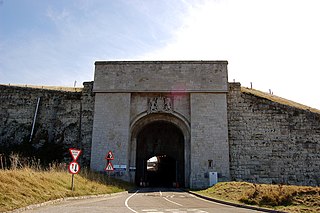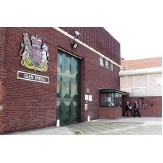
Northallerton is a market town and civil parish near the River Wiske, North Yorkshire, England. It is an administrative centre of the North Yorkshire District and has served as the county town of the North Riding of Yorkshire from 1889 to 1974 and of North Yorkshire from 1974 to 2023. The town lies in the Vale of Mowbray and at the northern end of the Vale of York. It had a population of 16,832 in the 2011 census, an increase from 15,741 in 2001. Northallerton is made up of four wards: North, Broomfield, Romanby and Central.

Appleton Wiske is a small village and civil parish that sits between Northallerton and Yarm in the Vale of York, a flat tract of land that runs between the North Yorkshire Moors to the east, the Yorkshire Dales to the west and the River Tees to the north.

Northallerton railway station is on the East Coast Main Line serving the town of Northallerton in North Yorkshire, England. It is 218 miles 36 chains (351.6 km) north of London King's Cross between Thirsk to the south and Darlington to the north. Its three-letter station code is NTR.

HM Prison The Verne is a Category C men's prison located within the historic Verne Citadel on the Isle of Portland in Dorset, England. Operated by His Majesty's Prison Service, HMP The Verne was established in 1949 and occupies the southern part of the citadel. After a brief spell as an Immigration Removal Centre in 2014–2017, HMP The Verne re-opened in 2018.

Scruton is a village and civil parish in the Hambleton district of North Yorkshire, England. It is 4 miles (6 km) west of Northallerton. According to the 2001 census the village had a population of 442, decreasing to 424 at the 2011 census.

HM Prison Frankland is a Category A men's prison located in the village of Brasside in County Durham, England. Frankland is operated by His Majesty's Prison Service, and is located next to HM Prison Low Newton, a closed women's prison.

Leeming Bar is a village in the civil parish of Aiskew and Leeming Bar, in North Yorkshire, England. The village lay on the original Great North Road before being bypassed. It is now home to a large industrial estate and the main operating site of the Wensleydale Railway. It is in the historic North Riding of Yorkshire.

HM Prison Leeds is a Category B men's prison, located at Gloucester Terrace in the Armley area of Leeds in West Yorkshire, England, which opened in 1847. Leeds Prison is operated by His Majesty's Prison Service, and is still known locally as Armley Gaol, the historical name of the prison.

HM Prison Full Sutton is a Category A and B men's prison in the village of Full Sutton, near Pocklington in the East Riding of Yorkshire, England. Full Sutton is operated by His Majesty's Prison Service, and holds 596 inmates, as of September 2018. The prison's primary function is to hold, in conditions of high security, some of the most difficult and dangerous criminals in the country.
HM Prison Albany is a Category B men's prison, situated on the outskirts of Newport on the Isle of Wight, England. The prison is operated by His Majesty's Prison Service. Albany is located next to Parkhurst, another Male/B prison and together they form HM Prison Isle of Wight.

HM Prison Brixton is a local men's prison, located in Brixton area of the London Borough of Lambeth, in inner-South London. The prison is operated by His Majesty's Prison Service.

HM Prison Glen Parva was an adult male prison and Young Offenders Institution, located in Glen Parva, Leicestershire, England. Glen Parva was operated by His Majesty's Prison Service from 1974 to 2017; from July 2011 onwards, it was an adult and young offenders institution.
HM Prison Coldingley is a Category C men's prison, located in the village of Bisley, in Surrey, England. The prison is operated by His Majesty's Prison Service.

HM Prison Moorland is a Category C men's prison and Young Offenders Institution, near Hatfield Woodhouse in South Yorkshire, England. The prison is operated by His Majesty's Prison Service, and is jointly managed with the nearby Hatfield Prison.

HM Prison Rochester is a male Young Offenders Institution, founded in 1874, and located in the Borstal area of Rochester in Kent, England. The prison is operated by His Majesty's Prison Service, and is located next to HMP Cookham Wood.
His Majesty's Prison Holme House is a Category C men's prison, located in Stockton-on-Tees, County Durham, England. The prison is operated by His Majesty's Prison & Probation Service.
HMP New Hall. is a closed-category prison for female adults, juveniles, and young offenders. The prison is located in the village of Flockton in West Yorkshire, England. New Hall is operated by His Majesty's Prison Service.

Friarage Hospital is a 189-bed hospital located in Northallerton, North Yorkshire, England. The hospital covers a large section of rural North Yorkshire and the Vale of York which amounts to over 120,000 people in 390 square miles (1,000 km2). The hospital is run by the South Tees Hospitals NHS Foundation Trust and is one of six hospitals in the trust's portfolio.

County Hall in Northallerton, North Yorkshire, England, serves as the headquarters of North Yorkshire Council. The building was opened in 1906 and has also been the headquarters of the North Riding County Council (NRCC) until 1974, and then North Yorkshire County Council until 2023. County Hall is at the south western edge of Northallerton and is a Grade II* listed building.

The North Northallerton bridge is a road bridge straddling the Northallerton–Eaglescliffe railway line in Northallerton, North Yorkshire, England. The bridge is on a link road connecting the A167 in the west, and the A684 in the east and in part, is intended to provide relief for the congestion caused in Northallerton due to the many level crossings which hold up road traffic. The link road runs through a set of new housing estates between Northallerton and Brompton, and has been beset by delays, originally intended for opening in late 2021, it was opened on 16 December 2022.


















